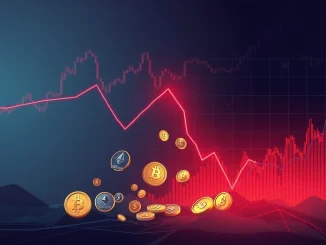
The world of cryptocurrency is constantly evolving, and its intersection with traditional finance is becoming increasingly significant. A recent statement from the U.S. Treasury highlights just how intertwined these two worlds are becoming, with a remarkable forecast for the future of stablecoin demand in the U.S. bond market.
What Did the Treasury Secretary Say About Stablecoin Demand?
According to Odaily News, U.S. Treasury Secretary Bessent has indicated a substantial and growing interest from stablecoin issuers in holding U.S. Treasury bonds. The Secretary projected that demand for these bonds stemming from the stablecoin sector is expected to reach a staggering $2 trillion, potentially even exceeding this figure.
This forecast underscores the increasing reliance of stablecoin reserves on traditional, low-risk financial assets like U.S. government debt. While the specific timeline for reaching this $2 trillion mark wasn’t detailed in the initial report, the projection itself signals a major potential flow of capital from the burgeoning crypto market into traditional debt markets.
Why Are Stablecoins Interested in U.S. Treasury Bonds?
Stablecoins are cryptocurrencies designed to minimize price volatility, typically by pegging their market value to some ‘stable’ asset. The most common type is pegged to a fiat currency, like the U.S. dollar (USD).
To maintain their peg and provide confidence to users, stablecoin issuers often back their tokens with reserves. These reserves typically consist of a mix of assets, including:
- Cash and cash equivalents
- Commercial paper
- Corporate bonds
- And, crucially, U.S. Treasury bonds and bills
U.S. Treasury bonds are considered among the safest investments globally. They are backed by the full faith and credit of the U.S. government. For stablecoin issuers, holding Treasuries in their reserves offers stability, liquidity, and a small yield, making them an attractive option for backing dollar-pegged stablecoins.
The Connection to the Dollar’s Reserve Status
Secretary Bessent’s comments, reportedly made in the context of the Trump administration’s stance, also reaffirmed a commitment to preserving the dollar’s status as the global dollar reserve currency. The significant stablecoin demand for U.S. bonds directly supports this goal.
Here’s why:
- Increased Demand: Stablecoins create a new, digital avenue for global demand for USD-denominated assets, particularly Treasuries.
- Reinforcing Utility: As more stablecoins are used for transactions globally, their backing by USD assets reinforces the dollar’s utility and importance in the digital economy.
- Liquidity: The deep liquidity of the U.S. Treasury market makes it an ideal place for stablecoin issuers to store and manage large reserves, further solidifying its central role in global finance.
This growing synergy suggests that stablecoins, far from being a threat to the dollar, could actually become a significant new source of demand for U.S. government debt and help extend the dollar’s influence into the digital realm.
What Does a $2 Trillion Demand Mean for the Crypto Market and Beyond?
The projection of $2 trillion in demand has significant implications:
- For Stablecoins: It highlights the potential for massive growth in the stablecoin sector. A $2 trillion reserve pool would imply a stablecoin market capitalization potentially much larger than today’s figures (currently in the hundreds of billions), suggesting widespread adoption.
- For the U.S. Treasury Market: While the U.S. Treasury market is vast (total outstanding public debt is in the tens of trillions), a $2 trillion influx from stablecoins represents a notable new source of demand, potentially impacting bond yields and liquidity.
- For Regulation: Such large sums tied up in reserves will inevitably draw further attention from regulators regarding transparency, risk management, and systemic stability within the stablecoin ecosystem.
- For the Broader Crypto Market: It signifies the increasing financial maturity of the crypto space, demonstrating its potential to interact with and influence traditional financial markets on a large scale.
This forecast paints a picture of a future where stablecoins are not just a niche crypto asset but a major player in global finance, deeply integrated with the infrastructure of the traditional economy via assets like U.S. Treasury bonds.
Key Takeaways and Future Outlook
Secretary Bessent’s projection is a powerful indicator of the potential scale of stablecoin adoption and its direct link to traditional financial stability. The anticipated $2 trillion in demand for U.S. bonds from stablecoin reserves underscores several critical points:
- Stablecoins are becoming a significant bridge between the crypto world and traditional finance.
- Their growth is creating substantial new demand for safe, liquid assets like U.S. Treasuries.
- This trend can reinforce the U.S. dollar’s position as the leading global dollar reserve currency in the digital age.
- The regulatory landscape for stablecoins will likely continue to evolve rapidly in response to this growth and integration.
As the crypto market matures, the interactions between digital assets and traditional financial instruments like bonds will only deepen. This forecast serves as a compelling reminder that the impact of cryptocurrencies extends far beyond speculative trading, influencing macro-economic factors like demand for government debt and the future role of global reserve currencies.
In Conclusion: A Bridge Between Worlds
The prospect of $2 trillion in stablecoin demand flowing into U.S. Treasury bonds is a remarkable forecast that highlights the increasing convergence of the crypto market and traditional finance. This trend not only signifies the potential for explosive growth in the stablecoin sector but also reinforces the enduring importance of the dollar reserve currency status in the digital age. As this relationship deepens, understanding these dynamics will be crucial for anyone navigating the evolving financial landscape.



